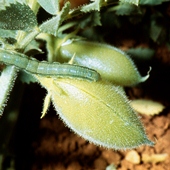
Scientists have successfully completed the draft genome sequence of chickpeas (Cicer arietinum), reported in an article published today in Nature Biotechnology. The study also describes the genome sequence of 90 cultivated and wild chickpea genotypes from ten countries. This is a veritable treasure trove of genomic resources, and paves the path for modern breeding to improve this important food crop – a great boost for chickpea farmers in the developing world.
Media Release – 28 January 2013
International team unravels the chickpea genome
New genomic resources will help create better chickpea varieties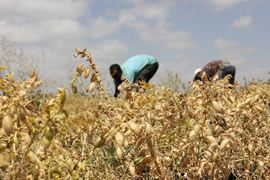 Scientists have successfully completed the draft genome sequence of chickpeas (Cicer arietinum), reported in an article published today in Nature Biotechnology. The study also describes the genome sequence of 90 cultivated and wild chickpea genotypes from ten countries. This is a veritable treasure trove of genomic resources, and paves the path for modern breeding to improve this important food crop – a great boost for chickpea farmers in the developing world.
Scientists have successfully completed the draft genome sequence of chickpeas (Cicer arietinum), reported in an article published today in Nature Biotechnology. The study also describes the genome sequence of 90 cultivated and wild chickpea genotypes from ten countries. This is a veritable treasure trove of genomic resources, and paves the path for modern breeding to improve this important food crop – a great boost for chickpea farmers in the developing world.
An auspicious start to 2013 in the genomics world, this study reveals more than 28,000 genes of chickpeas, which – together with an array of genotypes – provides millions of genetic markers. The initiative is summarised in the Nature Biotechnology article published today entitled Draft genome sequence of chickpea (Cicer arietinum) provides a resource for trait improvement. ![]() Download PDF
Download PDF
Chickpeas are an all-important staple for food security as a principal provider of protein, and are the world’s second most widely grown legume. They also enhance soil health, by fixing nitrogen and adding organic matter, meaning that farmers can intercrop chickpeas with other plants such as cereals, which benefit from the improved soil. As a result, “Farmers will not have to apply as much fertiliser or fungicides, which both reduces costs for the farmer and helps the environment,” explains Dr Paul Kimurto of Egerton University, Kenya, who is Lead Scientist for the Kenya component on improving chickpeas in the Generation Challenge Programme's (GCP) Legumes Research Initiative.
Underrated and alone, but with massive potential…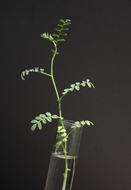 Chickpeas were formerly termed ‘orphan crop’, as they have a narrow genetic base – in part due to domestication, as only preferred qualities are carried on into the next generation. This, coupled with the lack of genomic data, meant that “Molecular breeding and improvement of chickpeas have been hindered by lack of genome sequence data, compared to other crops,” explains Prof Suk-Ha Lee of the Department of Plant Science, College of Agriculture and Life Sciences, Seoul National University, Korea.
Chickpeas were formerly termed ‘orphan crop’, as they have a narrow genetic base – in part due to domestication, as only preferred qualities are carried on into the next generation. This, coupled with the lack of genomic data, meant that “Molecular breeding and improvement of chickpeas have been hindered by lack of genome sequence data, compared to other crops,” explains Prof Suk-Ha Lee of the Department of Plant Science, College of Agriculture and Life Sciences, Seoul National University, Korea.
Prof Noel Ellis of the Institute of Biological, Environmental & Rural Sciences in Aberystwyth University, UK, concurs, adding: “This international study transforms the state of knowledge; it is not only a draft genome sequence, but also describes the genomes of 90 distinct chickpea types telling us much about the history of domestication and selection in this species. This wealth of genomic data now facilitates the development of breeding tools, and opens the door to many precise studies of gene function.”
One giant step…over the milestones…
Findings are bound to transform the fortunes of chickpea research, and those of chickpea farmers worldwide, particularly those who have had little choice but to plant low-yielding varieties, in addition to the devastations of drought and crop disease. Hardest hit are farmers in semi-arid environments with poor soils, poor agricultural infrastructure, and limited access to irrigation and fertilisers.
Prof Tim Close, Geneticist at the Department of Botany and Plant Sciences at the University of California, Riverside (USA) observes, “We now live in the light of the ‘genome era’. The article marks a major step forward, not only for chickpeas but for legumes in general.” The draft genome sequence serves as a ‘family tree’ for legumes, helping to clarify the roles that certain gene families have played in the evolution and domestication of chickpeas, and identifying genes for agronomically important traits to enhance other legumes.
Come together – over chickpeas…collaboratively
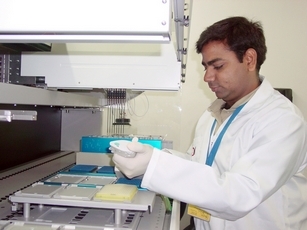
Dr RK Varshney in the lab.
So how did this breakthrough come through? Dr Rajeev K Varshney, the leader of the chickpea genome sequencing project, explains that an international like-minded group of about 10 scientists came together in July 2010 at the Vth International Conference on Legume Genetics and Genomics in Asilomar, USA. “We all agreed it was high time that we had a genome sequence for chickpeas.” Dr Varshney is also GCP’s Comparative and Applied Genomics Theme Leader, coordinator of the International Chickpea Genome Sequencing Consortium (ICGSC) and Director of the Center of Excellence in Genomics at the International Crops Research Institute for the Semi-Arid Tropics (ICRISAT). The sequencing project was partially funded by GCP.
Dr Varshney is elated to be part of this international Dream Team, comprising 49 scientists from 23 organisations in 10 countries, “I feel privileged and honoured to work with this group of scientists whose dedication made it possible to generate the genome sequence of chickpeas. Now it will be very important to link this genomic information to trait phenotypes, in order to apply the genomic information to breeding.”
This leads us to the next step: how this vast collection of resources will be put to
practical use in breeding. Prof Andreas Graner, Managing Director of the Leibniz Institute of Plant Genetics and Crop Plant Research in Germany, and a member of GCP’s Executive Board, explains, “The elucidation of the evolution of the chickpea genome and its domestication history now represent the framework to systematically apply DNA-sequence-based approaches to chickpea breeding. The present findings are a stepping stone to turn conventional chickpea breeding into a predictive science.”
Setting the scene
Prof Close elaborates on the context, “There has been a paradigm shift in biological research during the past few years, driven largely by a more than 2,000-fold reduction in the cost of DNA sequencing, and simultaneous improvements in computational methods. The rise of model systems has completely reshaped the landscape: each organism can be studied directly, and its significance determined by economic, social and ecological relevance. Here, we have an example of an international, culturally diverse group of individuals who have worked together to bring this paradigm shift firmly into the realm of a crop of major importance for world food security. It is inspiring!”
Considering today’s environmental challenges, particularly in the semi-arid regions, Dr David Bergvinson, Senior Programme Manager, Science & Technology, Global Development at the Bill & Melinda Gates Foundation, adds, “We look forward to seeing how researchers around the globe will harness this resource to increase chickpea productivity against the backdrop of climate change in the developing world.”
Hopes for the future…
What are the possible impacts of this finding? Dr Jean-Marcel Ribaut, GCP’s Director, explains, “With this new genome sequencing data, chickpeas – a crop of unquestionable nutritional and agricultural importance, especially in developing countries – now have the opportunity to benefit from modern breeding. This will yield new improved varieties to assist farmers in resource-poor communities, by increasing food security, generating more income and therefore improving their livelihoods in a significant way.”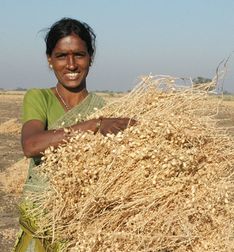
Renowned agricultural scientist and Member of Indian Parliament, Prof MS Swaminathan says, “I would like to compliment the excellent scientific work done by Rajeev Varshney of ICRISAT and his colleagues in developing a high-quality genome sequence of chickpea. I am confident that the knowledge provided by this study will help accelerate the improvement of this crop through marker-assisted breeding.”
Dr Swapan Datta, Deputy Director General – Crop Science, Indian Council of Agricultural Research (ICAR), explains the Indian context, “The chickpea genome sequence is expected to help in the development of superior varieties with enhanced tolerance to drought and resistance to several biotic stresses. India will benefit most from this genome sequence, our country being the largest producer of chickpeas.”
Dr Varshney concludes with a thought on the power of partnerships: “Collaboration can make anything possible, as it ushered chickpeas into the ‘club’ of genomic-resource-rich crops.”
Links: This email address is being protected from spambots. You need JavaScript enabled to view it. | Blog | ICRISAT video | ICRISAT press release | Improving chickpeas |
GCP videos (4-part series) | About GCP
